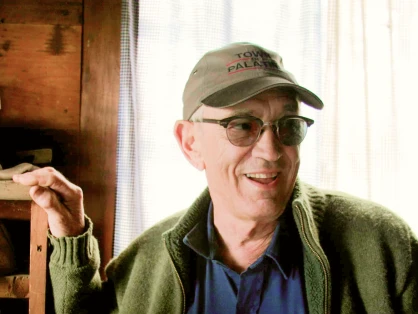An introduction to the “majestic apple” display at Fort Plain Free Library: Featured are a few of the many mechanical apple peelers patented and manufactured through the years, baskets to gather the apples and containers to hold the cider and vinegar. Of special interest are the artifact of long gone apple products from our own locality. A large brass stencil to mark the barrels of “Cider Vinegar” of George Flume of Palatine Bridge a lableled bottle that once held sparkling cider produced by JC Vosburgh and Sons of Canajoharie and a pakcking crate for JR Beach and Co of Palatine Bridge for their “Golden Russet Cider”.
The nip of fall is in the air. We cast an eye toward the mountains and nature’s changing colors. The corn, squash (pumpkins), and beans are being harvested. They were called by the native people the three sisters. We take almost for granted one noble fruit that has been a mainstay so long it might slip our mind. That noble fruit is the apple. Gnarled apple trees stare at us from home sites where the early settlers’ houses once stood. Where small children chose just the right apple to sit and eat along the trail or road. That special red one will be nice to take home to mother or to their teacher at a one room school that has also passed into oblivion. The same thing might still happen with the young folks of our Amish neighborhood even now in the twenty first century.
The majestic apple in legend is only surpassed by its importance and its usefulness to mankind. It appears that some form of the apple existed on the North American continent before the coming of immigrants from the old world. However better apple seeds came along with these settlers and within a few years apple trees were abundant in colonial America. In 1747 the Swedish botanist Peter Kahn toured North America. The report he wrote spoke of apples and their importance. His notation under “an apple beverage” describes a fermented apple juice and how to make it. His comment was that “one who has not tasted it before would not believe that such a palatable beverage could be prepared from apples.”
William Garlock was “California Bill Garlock” to those who knew him. He was born and lived about four miles south of Canajoharie, NY, near a place now called Marshville. His birthplace was a small farm but in the first five years of the 1850s he tramped the gold fields of Northern California. The year 1878 found him again searching for gold. Just when he became dedicated to establishing his own apple orchards and those of his neighbors is not known. Doubtless he had been familiar with the majestic apple from his earliest youth. I hold a small old notebook recording his travels for apple tree sales from 1888 to 1890. His diaries also record the days when the roads were rutted and muddy and difficult to walk on for the old man. On one occasion he wrote that the cold wind blew so hard he could barely stand but the apple tree sales trip went on anyway. Most of his travels were within about twenty five miles of his home. They were made in late fall or early spring. If some of the older residents today could search the pages of this little note book many would find the names of their forebears. At some of these customers William would stay for the night. Sometimes paying for his board in cash or trade for some special variety of seedling tree that the homeowner desired. In the early spring the young trees would be received by mail. All of his selling trips were made on foot. His own apple orchards were not neglected. It is recorded that he had 25 acres devoted to apples with about 3,000 trees. The early 1900s saw great crops of apples harvested. The yield from his orchard was about 1,000 barrels per year. Today his orchards are over grown and barely remembered. Those of his customers have doubtless suffered the same fate. It is still fitting to give “California Bill Garlock” wellearned credit for advancing the production of the majestic apple here in the middle Mohawk Valley.
The apple has held its importance down through the centuries. Are there any of us who do not remember the apple pie, apple cobbler, and baked apples of our youth? Do you remember the sweet smell of the cider mill? A recent advertisement on TV about bottled “hard cider” brings to mind the many forms of apple juice. The fresh pressed sweet cider was and still is a favorite for young and not so young. As nature changes sweet cider to the alcoholic hard cider might remind us that in days gone by when water was sometimes polluted a glass of hard cider might stave off sickness. The final stage is vinegar and that was all important in preservation of foods by pickling in the days before refrigeration. If you will permit the writer of these memories to go back 66 years to when I came to the Nellis Farm in Stone Arabia we will visit a cider mill. Fall is here and the best apples are stored in the cold cellar. Now let’s pick up the windfalls from the ground. We will put them into the burlap bags the family milk truck will be used to draw them to the cider mill just down the hill at Palatine Bridge. It is operated by Flume and Fuller. They have not only the cider mill but the feed mill where I pick up cow feed. We dump the apples onto a conveyor which will take them to the grinder which will transform them to a pulp. The pulp is now placed in clean burlap cloth and put under a huge hydraulic press. Once this pressing was done by hand under huge press screws. What comes out is delicious sweet cider.
Other cider mills I remember drawing the apples to were Brown Brothers in St Johnsville and the mill at Sammonsville. Each has now faded into the sunset. However cider mills yet exist where young and old can enjoy the sweet cider made from the majestic apple.
We can examine the importance of apples in early Stone Arabia by an excerpt from the will of William Brower dated February 10, 1751. William had come to settle in Stone Arabia from Schenectady in about 1739. His farm consisted of 150 acres. By his will he gave one half of his farm to his oldest son Arent and the remaining half to son Harman. Apparently Arent received the half which included the buildings and orchard. The following text is from the will: “That my son Arent Brower or his heirs shall give unto my son Harman Brower or his heirs apples out of my orchard for his own use yearly till such time or times as my son Harman or his heirs has apple trees which bear apples for his own use.”


